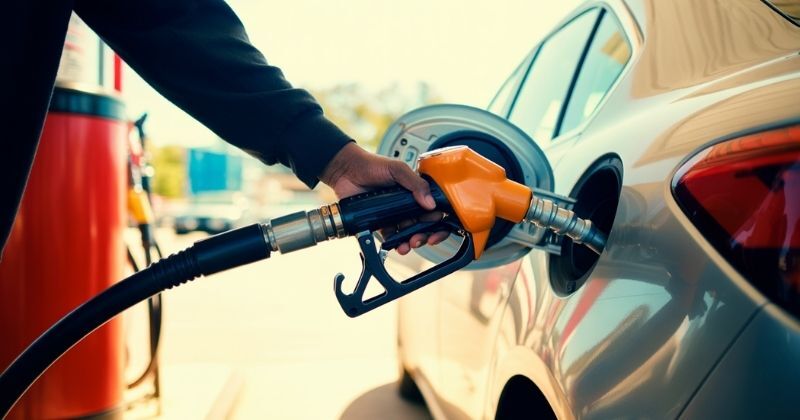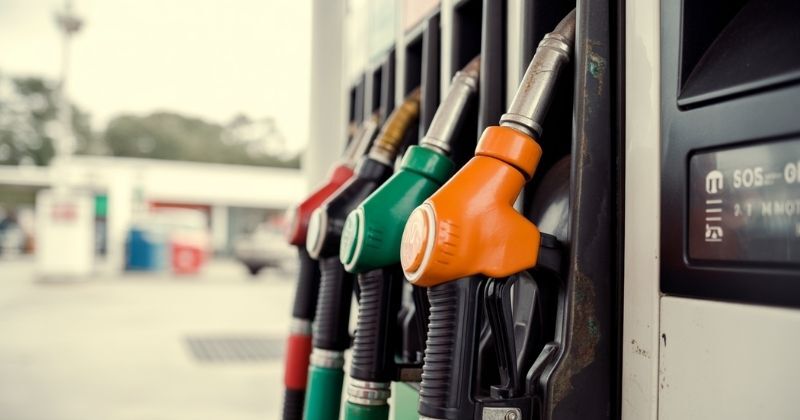
Despite the South African rand making notable gains against the United States dollar and global oil benchmarks trading within a fairly stable range, motorists are still not seeing meaningful relief. Petrol price recoveries remain deep in negative territory, while diesel prices are also beginning to drift in the same direction, raising concerns about what October will bring for fuel costs. South Africa imports the majority of its refined fuel, which means that even when crude oil prices are stable, the final cost at the pump is heavily influenced by both currency movements and international refining margins.
Key Takeaways
- Rand strength is the only buffer for fuel prices: Even though the local currency has been firm against the US dollar, international product prices are still outweighing the benefit, keeping petrol in under-recovery.
- Diesel remains slightly positive but vulnerable: Current over-recovery is slim, and any weakness in the rand or surge in oil prices could quickly tip diesel into higher costs.
- Global oil volatility continues to shape outcomes: Brief spikes in Brent crude and OPEC+ production strategies are influencing South Africa’s pricing, proving how exposed local fuel costs are to global market shocks.
About Arcadia Finance
Get the funding you need quickly with Arcadia Finance. There are no application fees, and you can compare options from 19 reputable lenders who meet National Credit Regulator standards. Experience a simple, reliable way to find the right loan for you.
Central Energy Fund Data Points to October Hikes
Figures released by the Central Energy Fund (CEF) at the conclusion of the third week of September highlight that petrol prices are still experiencing an under-recovery. This technical term essentially indicates that the market forces at play point towards an increase in pump prices when adjustments are announced in early October. Although the scale of the under-recovery has narrowed, largely assisted by the stronger rand, the underlying trend coming from international product prices continues to move higher, and this counteracts much of the positive currency impact. For everyday consumers, an under-recovery simply means that fuel suppliers are absorbing some of the costs in the short term, but these will eventually be passed down to drivers during the monthly price adjustment.
Mixed Contributions from Currency and Global Product Prices
The stronger rand is indeed contributing to a small measure of price recovery, estimated at approximately 11 cents per litre. However, this positive movement is overshadowed by international product price contributions, which remain negative and fall within a band of between -16 cents and -24 cents per litre. The overall picture, therefore, still reflects a net under-recovery for petrol, keeping pressure on consumers.
As a tip, motorists who want to cushion themselves from sudden hikes can consider using loyalty programmes offered by major fuel stations, which often provide cash-back rewards or discounts on every litre purchased. Over a month, these can amount to a meaningful saving.
Outlook for Individual Fuel Types
At the end of the third week, the expected adjustments for October based on current data appear as follows:
| Fuel Type | Expected October Adjustment | Direction of Change |
|---|---|---|
| Petrol 93 | +5 cents per litre | Increase |
| Petrol 95 | +13 cents per litre | Increase |
| Diesel 0.05% (wholesale) | -8 cents per litre | Decrease |
| Diesel 0.005% (wholesale) | -6 cents per litre | Decrease |
| Illuminating paraffin | -12 cents per litre | Decrease |
Illuminating paraffin remains an important household fuel in South Africa, especially in rural areas and informal settlements where it is still used for cooking, heating, and lighting. A 12 cent decrease might seem small, but for low-income households that rely on paraffin daily, these shifts can make a noticeable difference in monthly expenses.
The only positive interpretation of the current situation is that the under-recovery is now lower than what was recorded at mid-month, having improved by a few cents per litre. This progress is mainly driven by the resilience of the rand. However, analysts caution that should the local currency lose ground against the US dollar, the under-recovery could widen again and force fuel prices further into the red. For South Africans, this highlights how the exchange rate is not just a financial market concern but something that directly affects the cost of filling up a vehicle and even the price of food and transport services.

Diesel Prices Hold Up, But Outlook Remains Fragile
While the outlook for petrol is discouraging, diesel prices continue to show some resilience. Current calculations indicate that diesel remains in a state of over-recovery of around 7 cents per litre. This means that, if conditions were to remain constant, diesel prices might even see reductions. Nevertheless, the sustainability of this positive trend is being questioned.
Since the majority of South Africa’s goods are transported by road, diesel plays a central role in the cost of living. Any increase in diesel tends to ripple through into higher food prices, delivery costs, and public transport fares.
International Pressures Narrow the Gap
The challenge for diesel lies in the fact that international product prices have been trending upwards, which has gradually eroded the over-recovery position. At the start of the month, diesel was enjoying a cushion of roughly 20 cents per litre in its favour. This has since narrowed significantly to the current 7 cents, bringing the balance much closer to neutral. This narrowing trend shows how quickly external shocks, such as a rise in global freight charges or a disruption in refinery output, can filter into South Africa’s pricing models.
Risks of a Swing into Negative Territory
Because the margin has tightened, even a modest weakening of the rand or a further escalation in global oil prices could quickly swing diesel into negative recovery territory. Should this happen, the potential for a small diesel price hike in October cannot be ruled out. For now, however, the situation remains just on the safe side of neutral. Fleet owners and logistics companies are particularly sensitive to these shifts, and many hedge their fuel costs months in advance to avoid sudden financial shocks.
Monetary Policy and Rand Performance
Local Unit Benefits from US Federal Reserve Decision
One of the key factors supporting the rand in recent weeks has been monetary policy developments in the United States. The Federal Reserve opted to cut interest rates by 25 basis points, which expanded the rate differential between the US and South Africa to around 300 basis points. With the South African Reserve Bank having chosen to keep domestic rates on hold, the wider gap has made South African assets more attractive to international investors, bolstering the rand.
South Africa’s interest rate differential with the US has historically been one of the most important drivers of short-term capital flows, with investors seeking higher yields in emerging markets.
Rand Defies Other Economic Headwinds
What is noteworthy is that the rand has managed to maintain strength despite facing a series of potential headwinds. These include the newly implemented 30 percent tariff on certain exports to the United States and ongoing weak domestic economic data. The ability of the rand to remain firm against this backdrop has been a vital factor preventing fuel recoveries from worsening further. Consumers should keep in mind that the rand’s strength not only influences fuel prices but also plays a role in the cost of imported electronics, vehicles, and household appliances. A weaker rand means higher import costs, while a stronger rand provides temporary relief.

Oil Market Dynamics
Volatility Within a Narrower Range
While the rand has provided some assistance, international oil prices continue to be a major influence on fuel costs. The oil market has displayed volatility throughout the month of September, though overall prices remain within a relatively narrow range when compared to historic levels. However, relative to August and the early part of September, the fluctuations have been sharper and deeper. For context, during the global oil price crisis of 2008, Brent crude spiked above 140 US dollars per barrel. Today’s range around 67 to 70 US dollars per barrel looks modest by comparison, but in real terms, even small swings can heavily affect South African households.
Brent Crude Spikes and Retreats
The Brent crude oil price surged temporarily to around 70 US dollars per barrel during the week, driven largely by concerns over supply disruptions and mounting geopolitical tensions. This represented a significant jump from the 66 US dollar average that had characterised August and early September. The spike was triggered after Ukrainian drone attacks targeted Russian energy infrastructure, including vital export terminals and refineries, which raised fears of reduced supply. The price subsequently retreated back to around 67 US dollars per barrel, but because the spike occurred during the monthly pricing window, it will still be incorporated into the average used to set local fuel prices. Consumers should note that South Africa’s fuel pricing system uses an averaging method, which means even short-lived spikes are factored in, often leaving a lasting effect on monthly price adjustments.
OPEC+ Strategy and Global Supply Outlook
Decisions made by OPEC+ countries to manage production through a mix of output increases and cuts also contributed to upward pressure on prices. Yet despite these factors, market analysts have pointed out that expectations of a global supply surplus are outweighing fears about lost Russian exports. A faster-than-expected reversal in production curbs has led the International Energy Agency to forecast a record crude supply surplus for next year, which has tempered price gains. This broader outlook explains why oil prices remain largely bound within the narrow corridor around 67 US dollars a barrel, despite ongoing geopolitical risks. One interesting fact is that South Africa, while not a member of OPEC, is heavily influenced by OPEC+ decisions because nearly all of its refined products are priced against international benchmarks set by these producers.
Conclusion
South Africa’s fuel price outlook remains fragile, with the stronger rand offering only limited protection against international pressures. Petrol is set for modest increases in October, while diesel may still see reductions, although this position is weakening rapidly. The resilience of the rand has been crucial in containing costs, but any slip in the local unit or a renewed surge in global oil prices could quickly reverse the trend. For households and businesses alike, fuel remains a volatile expense tied as much to global geopolitics as to domestic economic conditions, reminding South Africans of the delicate balance that determines what they pay at the pump.
Fast, uncomplicated, and trustworthy loan comparisons
At Arcadia Finance, you can compare loan offers from multiple lenders with no obligation and free of charge. Get a clear overview of your options and choose the best deal for you.
Fill out our form today to easily compare interest rates from 19 banks and find the right loan for you.


